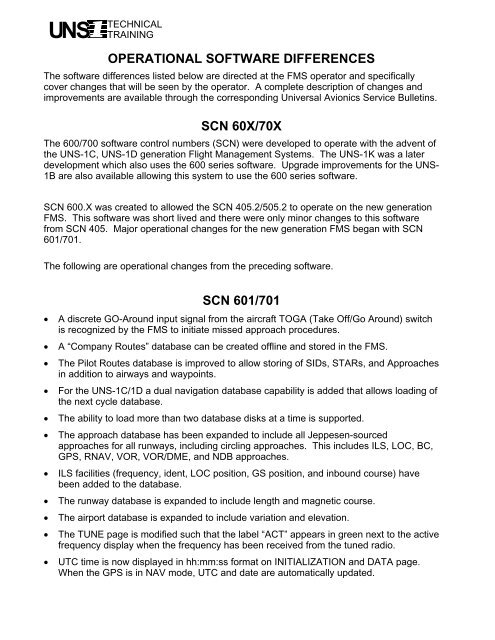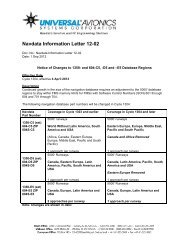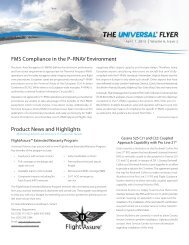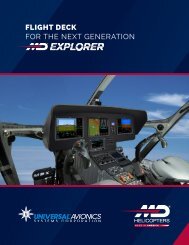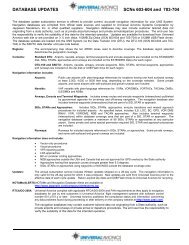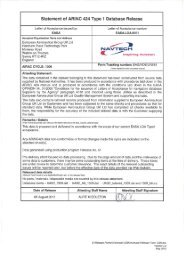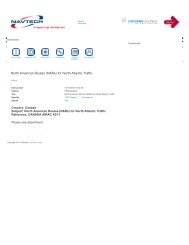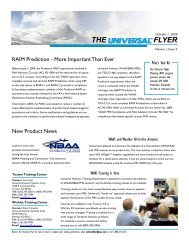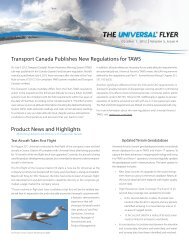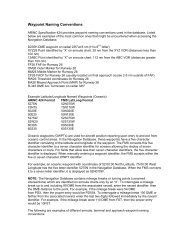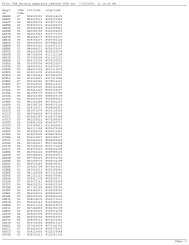FMS Software Differences 601 thru 1000 - Universal Avionics
FMS Software Differences 601 thru 1000 - Universal Avionics
FMS Software Differences 601 thru 1000 - Universal Avionics
You also want an ePaper? Increase the reach of your titles
YUMPU automatically turns print PDFs into web optimized ePapers that Google loves.
UNS TECHNICALTRAININGSCN 602/702• Automatic approach arming occurs at 30nm from the End of Approach.• Improved crossfill will push/pull crossfill options and triple <strong>FMS</strong> crossfill capabilities.• GPS overlay approaches are annotated with a “G” to indicate that GPS will remainselected during the approach.• The holding function is improved to allow holding pattern at multiple waypoints in theflight plan. Procedural holding patterns are added to the database and eliminate theneed to manually program holding patterns in SIDs, STARs, and Approaches.• HOLD ARM will be displayed as submode on the NAV page when the next leg is aHOLD.• Procedural heading leg data is displayed on the HSI. The HSI displays a centeredneedle when the aircraft is on the correct heading and the course pointer indicates thedesired heading.• The FUEL and FLT LOG pages are improved to allow the entry of total passengerweight.• A STANDBY power down mode is added. After flight plan and fuel data are enteredduring preflight, the <strong>FMS</strong> can be powered down using STANDBY mode and FUEL andFPL page data will be retained for up to eight hours.• <strong>Software</strong> Versions page is moved from DATA page 5 to a SW VERS line select keyunder MAINT on DATA page 1. Total DATA pages are now four.• All waypoint latitude/longitudes from the nav database are now displayed to 0.01minutes of resolution.• References to JEPP are changed to NAV in regards to labeling the nav database.• Support for UniLink is added.• The DISPLAY Processor software in the UNS-1C, 1D, and 1B+ with 5” FPCDU isimproved to support the display of weather graphics and other UniLink data.• Floating waypoint terminators are displayed on a variety of EFIS map displays.• All legs that terminate in floating waypoints are now displayed and referenced on theHSI.• The display of holding pattern flight plan legs are available on the A429, Pro Line 4 800and ASCB EFISs.• The holding pattern flight plan legs are displayed on the Pro Line 4 4000 EFIS as Holdicons.• Added EFIS interface for the Learjet 45 which includes altitude displays, interactiveheading bug, LNAV, VNAV, overspeed, and Approach Modes.• The Advanced Performance mode added sensed flap position, required field length,takeoff weight, and Static Air Temperature (SAT) limit computations.• Runway gradient and length are now available from the navigation database and areused for runway length required calculations.
UNS TECHNICALTRAINING• VNAV Top of Descent (TOD) alerting message is changed from FPA CHANGE to TOPOF DESCENT ALERT.• VNAV FPA CHANGE is changed to VERTICAL WPT ALERT.• Removed the restriction for VNAV operations to waypoints in a Standard InstrumentDeparture (SID).Refer to the applicable UASC service bulletin for a complete list of SCN 602 changes.
UNS TECHNICALTRAININGSCN 603/703• LOC and Backcourse (BC) approaches, using the VHF Nav receiver for lateral steering,is available. A pseudo-glideslope is generated for three dimensional navigation.• Added the message LOC STEERING ACTIVE for LOC and BC approaches to indicatewhen <strong>FMS</strong> is using raw localizer data for display and steering.• Changed lateral scaling to be angular down to 350 feet full scale at the runway for usein GLS, LOC, and BC approaches.• Added provisions for GPS Landing System (GLS) approaches.• Improved the TUNE NAVAID message for ILS, LOC, and BC approaches. It now reads,for example, “TUNE NAV TO ITUS ON 111.70”.• Add an auxiliary power unit (APU) fuel flow configuration item.• Added a configuration option to display either Q factor or the actual navigationperformance (ANP) and required navigation performance (RNP). RNP can be manuallyset.• Changed terminal scaling mode to activate when approach is armed, when the aircraft iswithin 30nm of the departure or destination, and when manually selected.• Changed track to fix (TF) leg to use facility declination instead of applying great circletrue heading magnetic calculation to TF leg.• Changed the route ident to 10 characters to match the UniLink route ident.• Changed the PERF Climb/Cruise page to display the ISA temperature corrections.• Commands the <strong>FMS</strong> to automatically change from the PERF takeoff pages to theclimb/cruise page after liftoff when Advanced Performance is configured.• Changed the Initialization page to highlight the ACCEPT prompt when the positionidentification is GPS and the date and UTC are valid.• Created new database status pages that provide the status of the database in the activeand inactive data banks.• Changed the FPL and DATA/NAV/APPR pages to display at or above, at or below, andwindow altitude constraints in small font.• Added a VNAV menu page that allows entry of a default target vertical speed that isstored in non-volatile RAM.• Changed the flight plan pages to allow entry of altitudes which will be used by the VNAVmode.Refer to the applicable UASC service bulletin for a complete list of SCN 603 changes.
UNS TECHNICALTRAININGSCN 604/704SCN 604 will support <strong>Universal</strong> <strong>Avionics</strong> new Terrain Awareness Warning System (TAWS),the <strong>Universal</strong> Cockpit Display (UCD), and remote tuning for the 8.33 Khz com radio spacing.It also includes the following operational changes.• The holding definition page will retain pilot defined holding when leaving that page andlater returning.• The Company routes database will include the provision for Company definedwaypoints.• Cargo weight under fuel page 1 is expanded to six digits.Refer to the applicable UASC service bulletin for a complete list of SCN 604 changes.
UNS TECHNICALTRAININGSCN 80X/90XThe 80X/90X <strong>Software</strong> Control Numbers (SCN) was developed to operate with the adventof the UNS-1E, UNS-1Esp, UNS-1F and UNS-1L generation Flight Management Systems.Upgrade improvements for the UNS-1C, 1D, and 1K are also available, allowing thesesystems to use the 80X series software. Most of the software improvements allow these<strong>FMS</strong>’s to work with new technology avionics and are transparent to the operator. Thesoftware differences listed below are directed at the <strong>FMS</strong> operator and specifically coverchanges that will be seen by the operator. A complete description of changes andimprovements are available through the corresponding <strong>Universal</strong> <strong>Avionics</strong> Service Bulletins.The Multi-Mission Management System (MMMS), 90X series software, provides thecapability to automatically steer along one of six search patterns.SCN 800/900 was created to allow SCN 604/704 to operate in the new generation <strong>FMS</strong>.SCN 800/900 was short lived, as there were only minor changes to this software from SCN604/704. (See Operators Training Manual, Report Number 3039sv60X/70X) Majoroperational changes for the new generation <strong>FMS</strong> begins with SCN 801/901.The following are operational changes from the preceding software.SCN 801/901• The enroute VNAV format changed to 6 vertical waypoints to work in conjunction withvertical waypoints on flight plan pages.• A better transition from Enroute VNAV to Approach VNAV allows VNAV to stay coupledduring approach activation.• Descent in holding patterns is now available.• An OFFSET function on the flight plan pages allows for creation of offset VNAV waypointthrough flight plan pages.• NAV MENU options allows for calculating ABEAM POINT, Radial Crossing, and 4LAT/LONG crossing points.• For a pilot created waypoint, airport, or alignment point, the <strong>FMS</strong> retains and displaysthe defining parameters.• The <strong>FMS</strong> will now notify the pilot when pilot defined routes and terminal area proceduresare affected by a new navigation database.• For lat/long waypoints the <strong>FMS</strong> allows for either 5 (ARINC) or 7 character format.• Precision Arc (RF) leg for lateral support in flight plans.• A new NAV page with ANP and RNP is added to the NAV display.• Creation of new temporary Tactical Waypoints for use in flight plans are now available.• Adds Top of Descent (TOD) to TAWS display.Refer to the applicable UASC service bulletin for a complete list of SCN 801 changes.
UNS TECHNICALTRAININGSCN 802/902• The COMPRESSED option is now on flight plan menu page 1, LSK 1L, with a newpresentation. A new option, REF ALT, is on page 2, LSK 1L. REF ALT is a TAWSrelated function.• On the flight plan menu arrival page under approach, RNP RNAV approaches are nowseparated from GPS approaches, with the designation of RNV.• The <strong>FMS</strong> is now capable of flying RNP RNAV approaches with multiple legs betweenthe FAF and MAP to include precision arc, track to fix, and course to fix legs with pseudoglideslope to less than RNP .3 on aircraft so certified.• The NAV menu contains a new feature, MAP DISPLAY. This allows for the suppressionof the missed approach transition on the map mode of the pilots flight display.• The performance menu page contains a new option ETP/PNR, Equal Time Point andPoint of No Return. Configuration allows for pilot inputs to determine engine failure andpressurization failure ETP/PNR.• The tune function of the <strong>FMS</strong> now contains a communication frequency database.• The method of construction of pilot created approaches has changed allowing formultiple fixes between the FAF and MAP.• Modification of seven-character oceanic waypoint identifier format to “xxNxxxW”Refer to the applicable UASC service bulletin for a complete list of SCN 802 changes.
UNS TECHNICALTRAININGSCN 803/903• Added a new route clearance page, accessed from the Pilot Route menu page, whichdisplays pilot-defined routes in clearance language format.• Added configuration setting to display and specify the time of day the navigationdatabase expires.• Modified selected crosstrack mode to maintain the parallel offset for certain leg typesthrough leg sequencing in order to comply with PRNAV and RNP RNAV.• Modified selected crosstrack entry field on the NAV page to correctly interpret theentered selected crosstrack value when the commanded heading mode is active.• Added a synchronized dual <strong>FMS</strong> feature. Pilot actions that affect LNAV, VNAV andFUEL are automatically and bidirectionally crossfilled.• Added the use of runways for tactical operations such as DTO, PVOR, and HOLD.• Added emergency divert feature to the DTO function. An emergency divert to a nearbyairport was previously available through the use of the LIST function to access a list ofnearby airports. This new feature will allow direct access to nearby airports from theDTO page and provide additional information such as range, bearing and maximumrunway lengths.• Added a Hold at Present Position (HOLD PPOS) option that enables pilot to enter aholding pattern at the current present position.• Modified software to allow missed approach selection for advisory approaches.• Modified software to restore the capability to do manual predicted RAIM for BC, LOCand ILS approach types.• Modified software to display approach magnetic variance accurately in the unique casewhen a flight plan is entered where there is no origin and an extra waypoint after thedestination.• Removed the Quality (Q) factor as a display option for Estimated Position Uncertainty(EPU).• Removed logic that allows display of EPU in Kalman Variances on the GWS Statuspage. EPU is now derived solely from and displayed as the GWS sensor horizontalfigure of merit (HFOM).Refer to the applicable UASC service bulletin for a complete list of SCN 803 changes.
UNS TECHNICALTRAININGSCN 100X/110XSCN 100X and the MMM version 110X, require a new <strong>FMS</strong>. The new <strong>FMS</strong> are the 1Ew,1Fw, and 1Kw. This software is adapted to integrate the Space Base Augmentation System(SBAS) into the navigation sensor suite. Under SBAS is WAAS for North America, EGNOSfor Europe and MSAS for Japan.The following are operational changes from the preceding software.SCN <strong>1000</strong>/1100• Added a "+" sign to indicate a positive value in the VDEV field on the VNAV Path Page.• Improved position accuracy calculations by refining inputs to the multi-sensor Kalmanfilter used to determine actual navigation performance (ANP).• Removed waypoint overfly as the default to the precision arc (RF) procedural leg typeand added an overfly (OVFLY) option to the SID, STAR and Approach RF Leg DefinitionPages.• On SID, STAR, and Approach Transitions, terminal (T) phase of flight is maintainedthroughout the procedure regardless of the distance from the departure or arrival airport.This is in addition to the standard terminal area of 30nm radius around the departureand arrival airport.• Improved software to ensure temperature compensation is not applied to manuallyentered altitudes at final approach course fixes (FACF).• Improved synchronization functionality to ensure SYNC mode is retained when twoindependent <strong>FMS</strong> with Selected Crosstrack (SXTK) active are synchronized.• Incorporated routine update to the magnetic variation model.• Modified software to prevent erroneous NO INTERCEPT message during large coursechanges.• Now shows multiple approaches of the same type to a same runway by adding anidentifier suffix to uniquely identify each approach.• Added the capability for deviation steered autopilots to fly advanced approaches. AnAdvanced Approach Deviation Steering configuration option was implemented to enablethis functionality.• Updated the missed approach functionality to maintain approach scaling and alertinguntil the missed approach waypoint is sequenced.• Modified software to maintain approach scaling on the first missed approach leg whenthat leg is a TF leg type.
UNS TECHNICALTRAINING• Added to the crossfill functionality GPS required and approved information to ensureGPS required and GPS allowed approaches are crossfilled, and to prevent thedeselection of the offside <strong>FMS</strong>’s GPS when the approach is armed.• Improved flight plan auto-link functionality to select the first instance of a waypoint whenmultiple waypoints exist in a terminal procedure, i.e. when a course reversal (HF leg)exists in the flight plan.• Modified approach logic to allow approach arm/activation when the flight plan isunlinked.• Modified software to use published required navigation performance (RNP) values fromthe navigation database (when an RNP value exists) for full scale lateral deviationoutput.• Removed automatic approach Predictive RAIM feature as it is no longer required perTSO-146b.• Added Space Based Augmentation System (SBAS); charted as RNAV (GPS or GNSS)approaches, to the navigation database.• Added GPS/WAAS sensor configuration options (antenna offsets, approved SBASproviders, analog deviation hi/lo level voltages) to configuration pages.• Added GPS/WAAS provisions to power-up, self test, configuration and initializationfunctions, including test and status of the WAAS/ARINC board.• Added select and deselect logic for the GPS/WAAS sensor. New WAAS sensor pagesprovide sensor status, integrity status, sensor and satellite selection/ deselection. DataPages 2 and 4 have been updated to reflect GPS/WAAS sensor status.• Added SBAS approach provisions to the flight plan function. This includes the ability toselect a SBAS approach by entering its Channel ID and displaying SBAS approacheswith a "W" prefix on approach lists to indicate LPV Level of Service (LOS) availability.• Added an RNAV Approach LOS page from which the SBAS approach LOS may beviewed or selected. The Navigation and Navigation Approach pages have been modifiedto provide access to this page. Level of service includes LNAV, LNAV/VNAV and LPV.• Improved the approach interface to support the selection of SBAS (RNAV (GPS))approaches and approach guidance function.• Revised <strong>FMS</strong> default RNP values for oceanic, enroute and approach flight phases toreflect greater accuracy requirements. Oceanic operations have been revised from 6.0nm to 4.0 nm; enroute from 2.8 nm to 2.0 nm; and approach from 0.5 to 0.3 nm.• Added a SBAS Approach LOS annunciation to the Navigation Approach Page.


